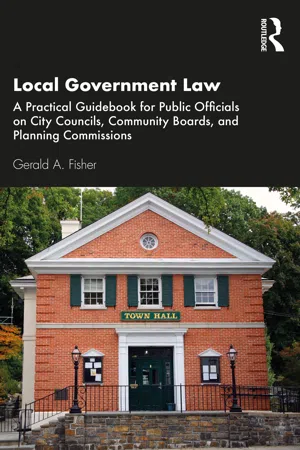
Local Government Law
A Practical Guidebook for Public Officials on City Councils, Community Boards, and Planning Commissions
- 254 pages
- English
- ePUB (mobile friendly)
- Available on iOS & Android
Local Government Law
A Practical Guidebook for Public Officials on City Councils, Community Boards, and Planning Commissions
About this book
Local Government Law provides a unique resource with concise, easy-to-understand explanations of important legal issues faced by local public officials, community boards, and city councils. From the moment officials take office, they face decisions related to basic principles found in state and federal law. The same is true for those in the private sector aiming to work successfully with local governments. This practical guidebook will empower public and private representatives with a functional grasp of legal principles, with chapters explaining what a local government is, the requirement to follow due process, local land use controls, the basics of the Freedom of Information Act, and many other important subjects that regularly arise. As a practical guidebook on local government law, this book provides a basic and empowering understanding for officials and private actors in the local government arena.
Frequently asked questions
- Essential is ideal for learners and professionals who enjoy exploring a wide range of subjects. Access the Essential Library with 800,000+ trusted titles and best-sellers across business, personal growth, and the humanities. Includes unlimited reading time and Standard Read Aloud voice.
- Complete: Perfect for advanced learners and researchers needing full, unrestricted access. Unlock 1.4M+ books across hundreds of subjects, including academic and specialized titles. The Complete Plan also includes advanced features like Premium Read Aloud and Research Assistant.
Please note we cannot support devices running on iOS 13 and Android 7 or earlier. Learn more about using the app.
Information
Chapter 1
Just What Is a “Local Government?”
A. The Federal-State Model
B. Our Founding Documents Begin the Story
1. Viewing “local government” in the broad context
2. “Splitting the Atom” of Sovereign Authority into State and Federal Spheres
- to establish and collect taxes;
- to provide for the defense of the country;
- to regulate interstate and foreign commerce;
- to coin money;
- to establish post offices;
- to establish patent, copyright, and trademark laws;
- to set up the federal court system under the Supreme Court;
- to declare war, and make rules concerning captures on land and water;
- to raise and support the army and navy, and provide for calling up and organizing of the militia to execute laws of the Union, suppress insurrections, and repel invasions;
- to make all laws necessary and proper for the execution of all the powers vested by the constitution.2
- entering into any treaty, alliance, or confederation;
- coining money;
- making anything but gold and silver coins a tender in payment of debts;
- passing an ex post facto law (one that retroactively changes the legal consequences of actions that were committed before the enactment of the law), bill of attainder (one that singles out an individual or group for punishment without a trial), or any law impairing the obligation of contracts.3
- charging a tax or duty on imports or exports (with limited exceptions);
- charging a duty for the weight of cargo;
- keeping troops or ships of war in time of peace;
- entering into any agreement or compact with another state or foreign power;
- engaging in war unless actually invaded or faced with imminent danger.4
C. State Constitutions and Legislatures Complete the Story
Table of contents
- Cover
- Half Title
- Title Page
- Copyright Page
- Contents
- Acknowledgments
- Introduction
- 1 Just What Is a “Local Government?”
- 2 Open Meetings Requirement
- 3 Procedural Rules for Meetings
- 4 Public Access to Government Records
- 5 Federal Constitutional Limits on Local Governments
- 6 Law-Making Powers of Voters
- 7 Fair Housing
- 8 Financing Local Government
- 9 Background and Importance of Zoning
- 10 Non-Zoning Land Use Controls
- 11 Interlocal Agreements
- 12 Eminent Domain and Regulatory Takings
- 13 Meet the Court System and Local Attorney
- 14 Avoiding Personal Liability
- Index